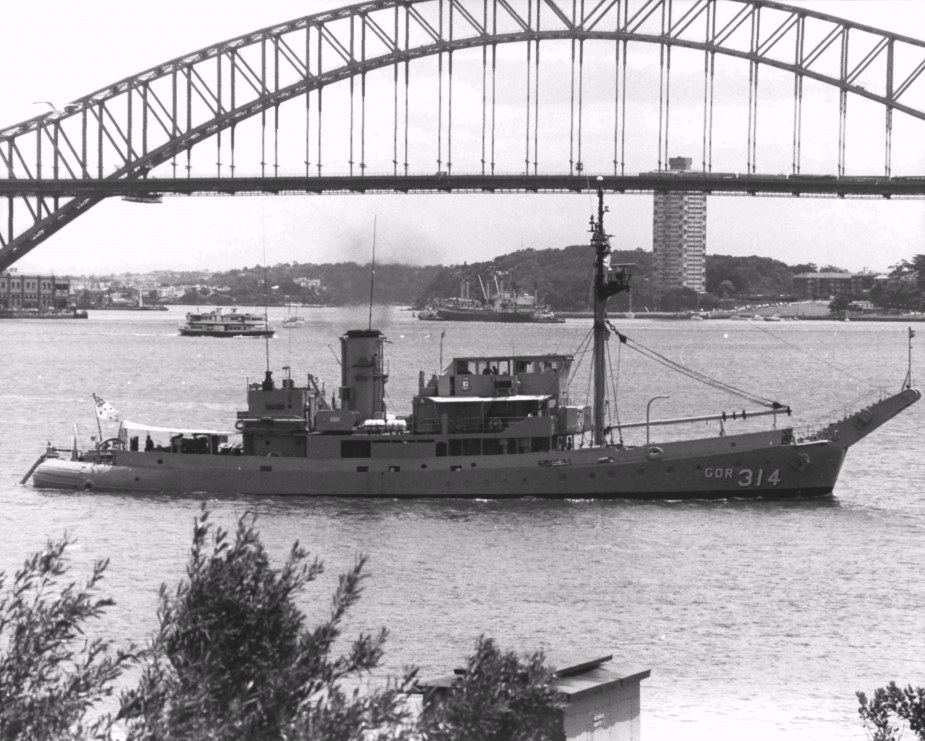HMAS Kimbla was built as a boom defence vessel by Walkers Ltd of Maryborough, Queensland. Laid down on 4 November 1953 she commissioned into the RAN on 26 March 1956 under the command of Lieutenant Commander Arthur R Pearson, RANVR. In her role as a boom defence vessel, Kimbla was easily distinguishable by a pair of ‘horns’ mounted on her bow, her solid rounded stern and associated large mooring anchor.
Kimbla initially operated on the Australian coast and in New Guinea waters laying and maintaining moorings. Following conversion to a trials vessel in December 1958, Kimbla spent three months conducting survey duties in the Lord Howe Island area between January and March 1959.
In the early 1960s Kimbla participated in a number of salvage operations, an often unpleasant but vital role. The first of these came on 12 June 1960 after a Fokker Friendship passenger aircraft crashed into the sea off Mackay, Queensland, killing 29 people. On that occasion Kimbla assisted HMAS Warrego in recovering the wreckage of the aircraft.
On 30 November the following year Kimbla was involved in a similar operation when an Ansett Airline Vickers Viscount aircraft crashed into Botany Bay, NSW, killing 15 people.
Kimbla was again called upon for such work in October 1962 when she salvaged a wrecked RAN Sea Venom aircraft off Jervis Bay and again in 1978 when she salvaged an F-111 fighter-bomber lost off New Zealand.
Kimbla’s normal duties involved oceanographic research work, which was neither glamorous or headline grabbing. In that role she conducted considerable research for both naval and scientific purposes. Such research included trials for the RAN Research Laboratory (RANRL), programmes for the Commonwealth Scientific & Industrial Research Organisation (CSIRO), the NSW Department of Mines as well as a number of tasks for universities and museums. One such CSIRO survey involved charting the East Australian current and evaluating anomalies experienced by mariners in the Port Stephens and Nelson Bay areas of NSW.
For many years, Kimbla’s wind and tide assisted speed of only twelve knots was the subject of derision from other fleet units and over time she affectionately became known as the ‘Snail’. Embracing this nickname, Kimbla was often seen entering harbour flying a large flag depicting a caricature of the well known mollusc this was later replaced by a more permanent fixture on her funnel. In practice, her speed impediment proved invaluable in her role as an oceanographic research vessel as she was the only RAN ship capable of steaming continuously at just three knots without incurring damage to her engines - an ideal speed for the work she was involved in.
Kimbla’s tasks also included laying moorings on the continental shelf at depths of between 75 and 100 fathoms off Sydney and Cronulla. Beyond the continental shelf, Kimbla was employed in other valuable work towing a geomagnetic electrokinetograph (GEK) used to study ocean currents.
Other tasks included launching expendable bathythermographs used to evaluate sea temperatures and trace sea currents through local waters. This work was part of a program overseen by CSIRO oceanographers to study the effects of the offshore East Australian current on the continental shelf.
Tragedy struck Kimbla on 31 August 1979, when Chief Petty Officer Rodney Jackson was washed overboard in heavy seas while the ship was leaving Port Phillip Bay, Victoria. In spite of a widespread air and sea search no trace of Chief Petty Officer Jackson was found. His loss amongst Kimbla’s close knit crew and throughout the wider navy community was keenly felt. Rough weather could often curtail oceanographic survey work and on another occasion while conducting a seismographic survey between Sydney and Wollongong Kimbla weathered a 46 degree roll.
During her final voyage of 1984, Kimbla recorded surface data in the Tasman Sea for comparison with images received from the space shuttle Columbia’s synthetic aperture radar - a system which uses micro waves to obtain images of sea and land surfaces.
Throughout her life, Kimbla had set trawls and buoys, streamed odd shaped devices, sampled water, recorded ocean currents and completed myriad other tasks earning a reputation for reliability and usefulness that belied her appearance and age.
During her long career Kimbla steamed 363,038 nautical miles at an average speed of just seven knots. At the time of her decommissioning on 15 February 1985 Kimbla held the distinction of being the longest serving commissioned ship in the RAN and the last to use a reciprocating steam engine as a form of propulsion.
Specifications
| Type |
Oceanographic Research Ship (Ex Boom Working Vessel) |
|---|---|
| Pennant |
A314 |
| Builder |
Walkers Ltd, Maryborough, Queensland |
| Laid Down |
4 November 1953 |
| Launched |
23 March 1956 |
| Commissioned |
26 March 1956 |
| Decommissioned |
15 February 1985 |
| Dimensions & Displacement | |
| Displacement |
|
| Length | 179 feet |
| Beam | 32 feet |
| Draught | 12 feet |
| Performance | |
| Speed | 10 knots |
| Complement | |
| Crew |
|
| Propulsion | |
| Machinery | Triple expansion steam reciptocating engine |
| Armament | |
| Guns |
|

